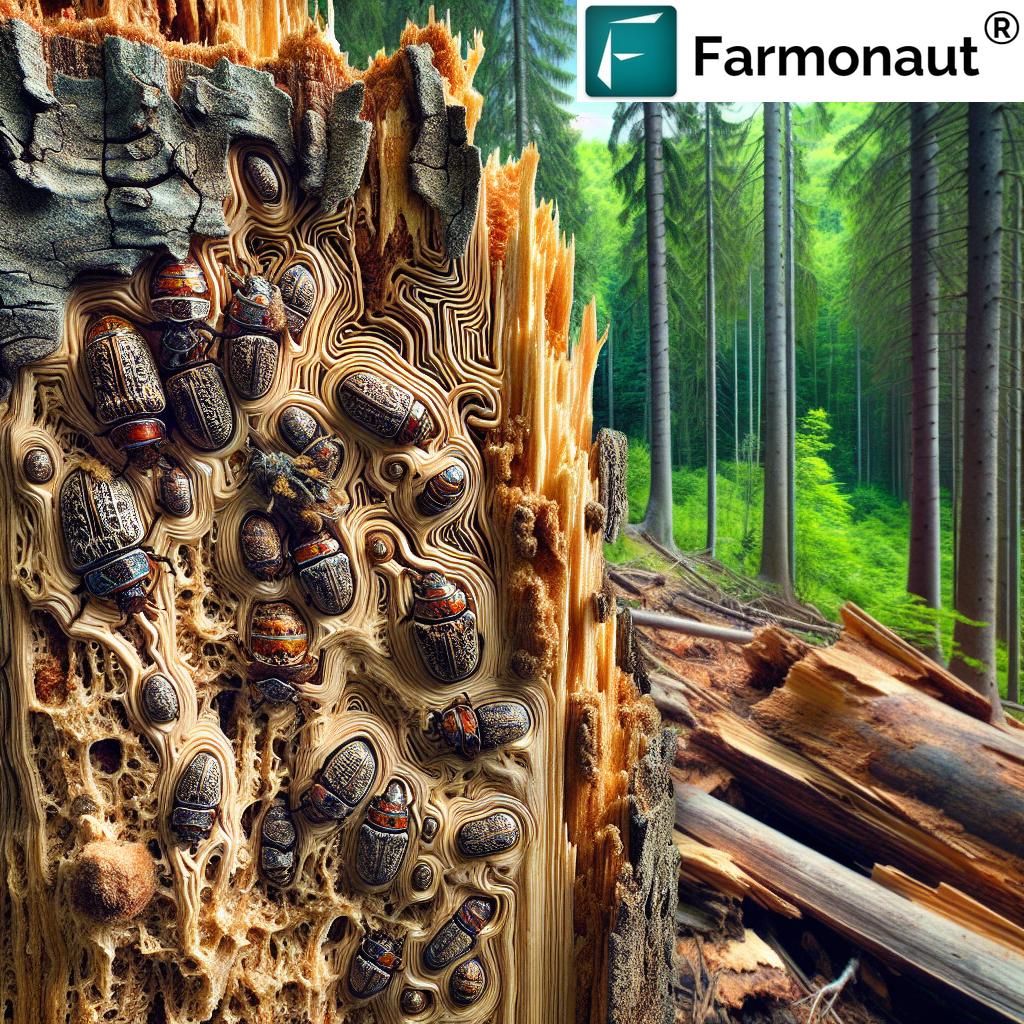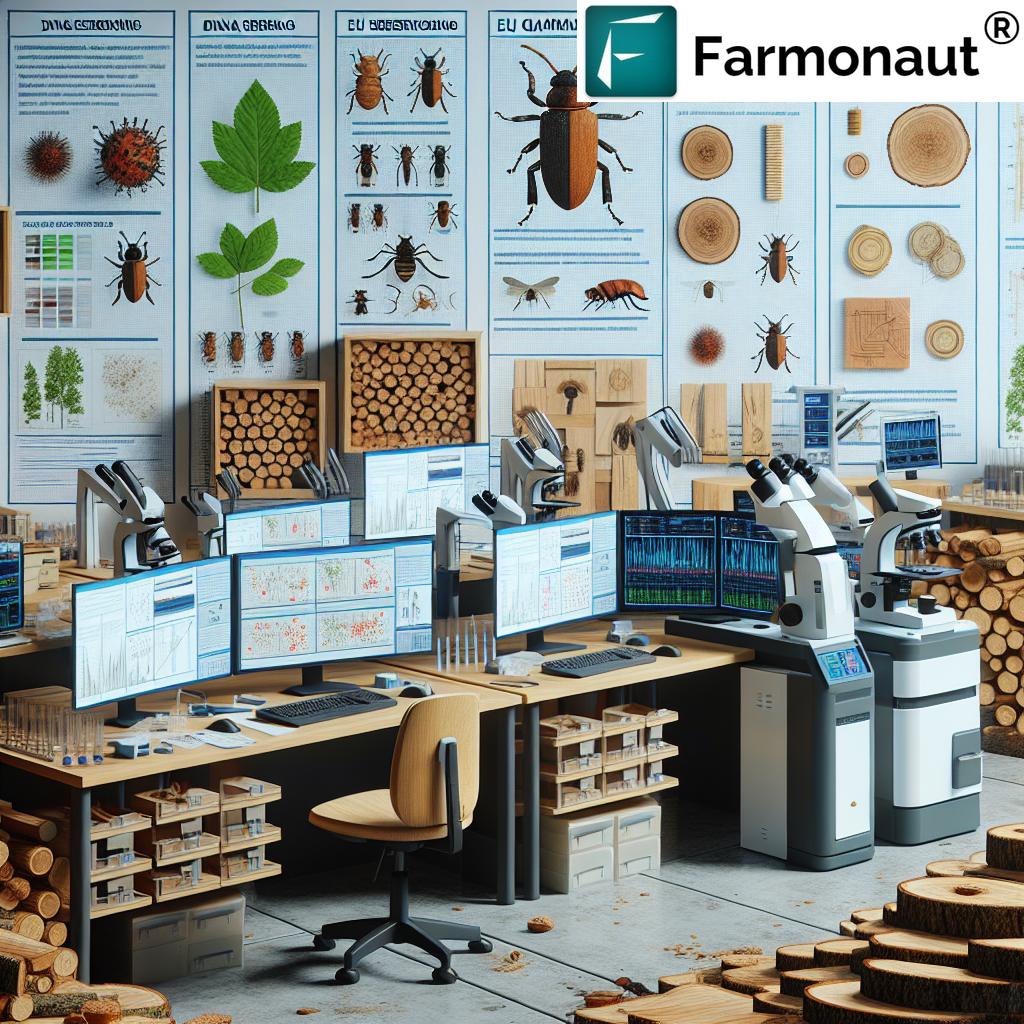Farmonaut Reveals: EU’s Top 12 Plant Health Risks from Bark Beetles and How to Protect Your Crops
“A recent study identified 12 high-risk bark and ambrosia beetle species out of 6,495 assessed, threatening EU forests.”
In the ever-evolving landscape of European agriculture, plant health risks and pest management have taken center stage with the recent identification of 12 high-risk bark and ambrosia beetle species threatening EU forests. At Farmonaut, we understand the critical importance of this groundbreaking research and its implications for the agricultural sector. As pioneers in satellite-based farm management solutions, we’re committed to keeping you informed about the latest developments in plant health and providing cutting-edge tools to protect your crops.
In this comprehensive blog post, we’ll delve into the details of this crucial study, explore the potential impacts on EU forests, and discuss how Farmonaut’s advanced technology can support early detection and management of these forest pest threats. Let’s embark on this journey to safeguard plant health across Europe together.
Understanding the Bark Beetle Threat
The recent study, which assessed a staggering 6,495 beetle species, has brought to light 12 high-risk bark and ambrosia beetle species that pose significant threats to broadleaved trees in the European Union. These findings underscore the urgent need for robust wood import regulations and effective tree disease prevention strategies.
- Bark beetles are small insects that burrow into tree bark, potentially causing severe damage to forests.
- Ambrosia beetles, a subset of bark beetles, cultivate fungal gardens within trees, leading to further complications.
- Both types of beetles can introduce harmful pathogens, accelerating tree decline and mortality.
The identification of these 12 high-risk species serves as a crucial step in developing targeted plant pest management strategies and enhancing agricultural ecosystem protection measures across the EU.

The EU’s Response: #PlantHealth4Life Campaign
“The #PlantHealth4Life campaign addresses economic and environmental impacts of plant health risks across the European Union.”
In response to these emerging threats, the EU has launched the #PlantHealth4Life campaign. This initiative aims to raise public awareness about the economic and environmental significance of plant health. As part of this campaign, stakeholders across the agricultural sector are being educated on:
- The importance of vigilant bark beetle identification
- Effective ambrosia beetle control measures
- The role of EU quarantine pests regulations in protecting plant health
- Best practices for forest pest control
At Farmonaut, we fully support this initiative and are actively working to integrate the latest plant health insights into our satellite-based monitoring systems. Our advanced technology can play a crucial role in early detection and management of potential pest outbreaks.
EU’s Top 12 High-Risk Bark and Ambrosia Beetle Species
To provide a clear overview of the threat landscape, we’ve compiled a table summarizing the EU’s top 12 high-risk bark and ambrosia beetle species. This information is crucial for farmers, foresters, and policymakers in developing targeted prevention and control strategies.
| Species Name | Primary Host Trees | Estimated Economic Impact (€ millions/year) | Current Distribution | Potential Spread Risk | Recommended Prevention Measures |
|---|---|---|---|---|---|
| Xylosandrus compactus | Broadleaved trees | 50-100 | Southern Europe | High | Strict wood import controls, regular monitoring |
| Euwallacea fornicatus | Various hardwoods | 75-150 | Not present in EU | Medium | Quarantine measures, early detection systems |
| Hypothenemus hampei | Coffee plants | 200-300 | Limited presence | High | Pest-resistant cultivars, biological control |
| Ips typographus | Spruce trees | 500-1000 | Widespread in EU | High | Forest management, pheromone traps |
| Dendroctonus ponderosae | Pine trees | 100-200 | Not present in EU | Medium | Strict wood import regulations, surveillance |
| Xyleborus glabratus | Lauraceae family | 50-100 | Not present in EU | Medium | Quarantine measures, host tree monitoring |
| Pityophthorus juglandis | Walnut trees | 25-75 | Limited presence | High | Sanitation, chemical control |
| Scolytus multistriatus | Elm trees | 150-250 | Widespread in EU | High | Resistant elm varieties, insecticide treatments |
| Anisandrus maiche | Various hardwoods | 20-50 | Not present in EU | Low | Import restrictions, early detection |
| Xylosandrus crassiusculus | Broadleaved trees | 30-80 | Southern Europe | High | Quarantine, cultural control methods |
| Cnestus mutilatus | Various hardwoods | 15-40 | Not present in EU | Low | Phytosanitary measures, monitoring |
| Dendroctonus micans | Spruce trees | 100-200 | Northern and Central Europe | Medium | Biological control, silvicultural practices |
This table provides a comprehensive overview of the most significant bark and ambrosia beetle threats to EU forests. By understanding the characteristics, distribution, and potential impact of these species, stakeholders can develop more effective strategies for plant pest management and forest pest control.
Implications for EU Agriculture and Forestry
The identification of these high-risk beetle species has far-reaching implications for EU agriculture and forestry sectors:
- Economic Impact: Potential losses in the hundreds of millions of euros annually
- Biodiversity Threats: Risk to native tree species and forest ecosystems
- Climate Change Interactions: Increased vulnerability of trees stressed by changing climate conditions
- Trade Considerations: Potential restrictions on wood and plant material exports
At Farmonaut, we recognize the critical nature of these challenges. Our satellite-based monitoring systems are designed to provide early detection of potential pest outbreaks, allowing for timely intervention and mitigation strategies.

Farmonaut’s Role in Plant Health Management
As a leading provider of satellite-based farm management solutions, Farmonaut is at the forefront of plant health monitoring and pest management. Our advanced technology offers several key benefits in the fight against bark and ambrosia beetles:
- Early Detection: Our satellite imagery can identify signs of tree stress and potential pest infestations before they become visible to the naked eye.
- Large-Scale Monitoring: We can monitor vast forest areas efficiently, providing a comprehensive view of plant health across regions.
- Data-Driven Decision Making: Our AI-powered analytics help forestry professionals and policymakers make informed decisions about pest control and resource allocation.
- Integration with Pest Management Strategies: Farmonaut’s technology can be seamlessly integrated with existing pest management protocols, enhancing their effectiveness.
To learn more about how Farmonaut can support your plant health management efforts, explore our web application or download our mobile apps:
Best Practices for Plant Health Protection
To safeguard EU forests and agricultural ecosystems from the threats posed by bark and ambrosia beetles, it’s crucial to implement a range of preventive measures and best practices:
- Strict Wood Import Regulations: Implement and enforce rigorous phytosanitary measures for all imported wood and plant materials.
- Enhanced Surveillance: Establish comprehensive monitoring programs to detect early signs of beetle infestations.
- Quarantine Measures: Isolate and treat infected areas to prevent the spread of pests to healthy forests.
- Biological Control: Introduce natural predators and parasitoids to help control beetle populations.
- Resistant Tree Varieties: Promote the planting of tree species and varieties that show resistance to bark and ambrosia beetles.
- Sanitation Practices: Remove and properly dispose of infested trees and wood material to reduce pest populations.
- Chemical Control: When necessary, use approved insecticides as part of an integrated pest management approach.
- Public Awareness: Educate the public about the importance of plant health and their role in preventing pest spread.
By implementing these practices and leveraging advanced technologies like Farmonaut’s satellite-based monitoring, we can significantly improve our ability to protect EU forests from the threat of bark and ambrosia beetles.
The Future of Plant Health Management in the EU
As the EU continues to evaluate potential pest threats and develop new strategies for plant health management, several key trends are emerging:
- Increased Use of Technology: Advanced tools like satellite monitoring, AI, and machine learning will play a growing role in pest detection and management.
- Cross-Border Collaboration: Enhanced cooperation between EU member states in sharing data and coordinating responses to pest threats.
- Climate-Adaptive Strategies: Development of pest management approaches that account for the impacts of climate change on forest ecosystems.
- Integrated Pest Management: A holistic approach combining various control methods for more effective and sustainable pest management.
At Farmonaut, we’re committed to staying at the forefront of these developments, continuously improving our technology to meet the evolving needs of the agricultural and forestry sectors.
Farmonaut’s Commitment to Plant Health
As we navigate the challenges posed by bark and ambrosia beetles in EU forests, Farmonaut remains dedicated to providing cutting-edge solutions for plant health management. Our comprehensive suite of tools, including real-time crop health monitoring, AI-based advisory systems, and resource management tools, are designed to support farmers, foresters, and policymakers in their efforts to protect and nurture our vital plant resources.
To explore how Farmonaut can enhance your plant health management strategies, visit our web application or check out our API for developers looking to integrate our powerful satellite and weather data into their own systems.
For those interested in the technical aspects of our solutions, we invite you to review our comprehensive API Developer Docs.
Conclusion
The identification of 12 high-risk bark and ambrosia beetle species threatening EU forests marks a significant milestone in our ongoing efforts to protect plant health across Europe. By combining rigorous scientific research, advanced technology, and collaborative strategies, we can work together to mitigate these threats and ensure the long-term health and productivity of our forests and agricultural ecosystems.
At Farmonaut, we’re proud to be part of this important endeavor, providing innovative solutions that empower stakeholders to make informed decisions and take proactive measures in plant health management. Together, we can build a more resilient and sustainable future for European agriculture and forestry.
FAQ Section
Q: What are bark and ambrosia beetles?
A: Bark and ambrosia beetles are small insects that burrow into tree bark. Bark beetles feed on the inner bark, while ambrosia beetles cultivate fungal gardens within the wood for food.
Q: How do these beetles threaten EU forests?
A: These beetles can cause significant damage to trees by burrowing into the bark, disrupting nutrient flow, and introducing harmful pathogens, potentially leading to tree death and forest decline.
Q: What is the #PlantHealth4Life campaign?
A: It’s an EU initiative aimed at raising public awareness about plant health risks and their economic and environmental impacts across the European Union.
Q: How can Farmonaut help in managing plant health risks?
A: Farmonaut provides satellite-based monitoring systems that can detect early signs of tree stress and potential pest infestations, allowing for timely intervention and management.
Q: What are some key prevention measures against bark and ambrosia beetles?
A: Key measures include strict wood import regulations, enhanced surveillance, quarantine measures, biological control, planting resistant tree varieties, and implementing good sanitation practices.





